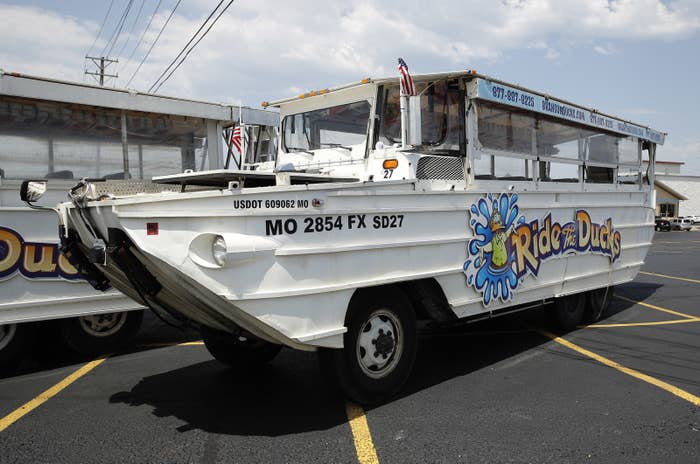
A recording from the Branson, Missouri, duck boat that sank with 31 people on board suggests its captain checked weather radar and attempted to complete the lake tour ahead of a fast-moving storm.
High winds and waves capsized the amphibious vehicle on Table Rock Lake on July 19, leaving 17 people dead and seven others injured. The lake had been placid when the tour began, but weather forecasts, radar, and National Weather Service alerts warned a severe thunderstorm would impact the region.
On Friday, the National Transportation Safety Board (NTSB) released its initial review of the boat's digital recording system, which had been recovered by divers. The NTSB's full report, which will officially determine the cause of the fatal sinking, is expected next year.
According to the NTSB, the boat’s driver and captain — who operate the craft on land and water, respectively — boarded the duck boat at 6:27 p.m. A minute later, someone came up to the boat and told them to take the water portion of the tour first.
At 6:29 p.m., the captain made a reference to checking the weather radar as passengers boarded. Three minutes later, the National Weather Service upgraded its thunderstorm watch to a severe thunderstorm warning for the Branson area, including the lake.
Severe Thunderstorm Warning including Branson MO, Hollister MO, Cassville MO until 7:30 PM CDT
The boat departed the terminal at 6:33 p.m. After a passenger safety briefing, the boat hit the water at 6:55 p.m. “The water appeared calm at this time,” the NTSB said.
For the next few minutes, all was well. The captain allowed children on board to try sitting in his seat as he supervised. But at 7 p.m., winds kicked up and white-capped waves appeared. The captain took back his seat, and the driver lowered plastic curtains over the craft’s windows — its main emergency exits.
At 7:01 p.m., the captain commented on the storm, and he made a radio call at 7:03 p.m. The bilge alarm — which would have detected water inside the boat — sounded at 7:04 p.m. The captain hit the alarm and again made a radio call.
By 7:07 p.m., the alarm went off again and waves could be seen splashing inside the boat. When the recording ended a minute later, the boat was still above water.
Law enforcement received the first 911 call about the boat capsizing at 7:09 p.m., said Stone County Sheriff Doug Rader.
The NTSB will continue to analyze the recording to create a full transcript, and its investigation will also include a review of the boat and its maintenance, as well as the Coast Guard’s oversight and actions by Ride the Ducks Branson employees. Captain Kenneth Scott McKee was among the 14 survivors of the incident. The boat’s driver, Bob Williams, died.
Ripley Entertainment, which owns Ride the Ducks in Branson, said as a party in the ongoing NTSB investigation, it may not comment. The company hasn’t publicly answered questions about its procedures on monitoring the weather or how employees are trained to act in emergencies.
Previous NTSB investigations called for retrofits to prevent deaths in duck boat accidents. By design, the boats began to sink almost immediately after taking on water, the NTSB said. Shade canopies and window coverings blocked passengers from escaping, pulling them underwater with the sinking boat.
In its sample regulatory guidelines, the Coast Guard said duck boats shouldn’t be in water during winds of more than 28 mph or when waves are over a foot high. Winds were reported at more than 63 mph when the Branson duck boat sank, and waves in the area were seen as high as five feet.
The stretch duck design of the Branson boat — an extended remodel of the original WWII-era craft — has also come under fire. Ride the Ducks Seattle stopped using the stretch duck after a fatal crash in 2015. Court records associated with that crash show it was designed by a self-taught duck boat entrepreneur who had no formal engineering training.
